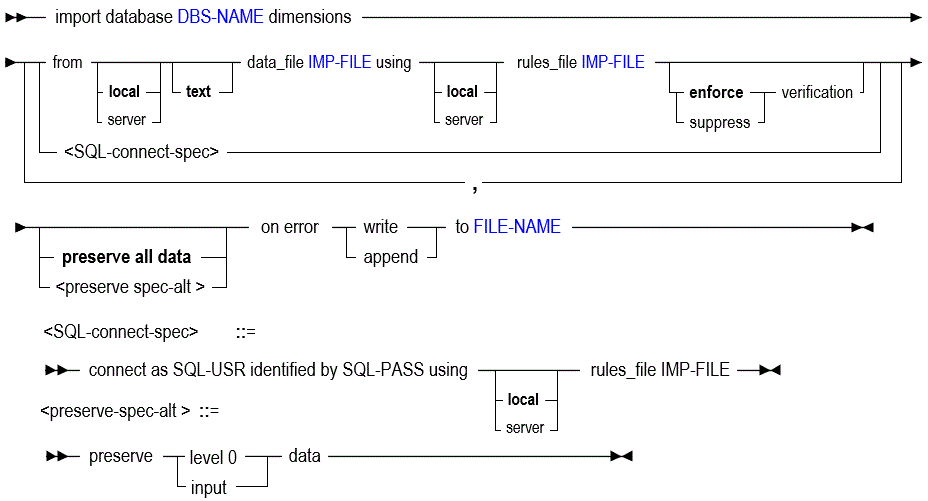Import Dimensions
The MaxL import dimensions statement helps you load dimensions into an Essbase database. The minimum application permission required to load data or dimensions is Database Update.
Keywords
You can import dimensions to a database in the following ways using MaxL import dimensions.
- import database DBS-NAME dimensions from ...
-
Specify whether the dimension import is from a local or server file, and what type of file to import the dimension from.
- import database … dimensions … using ... rules_file ...
-
Import dimensions into the database outline using a specified rules file. A separate rule file is required for each unique, non-Essbase source of data. If you're only re-importing data from native Essbase export files, you may not need to use a rule. If you are loading to a federated partition application, no load rule is required if you use a DBMS formatted CSV source file. You can make one using the DATAEXPORT calculation command with DataExportCSVFormat option.
- import database … dimensions … enforce verification ...
-
Verify the outline resulting from the dimension build. This is the default behavior.
- import database … dimensions … suppress verification ...
-
Do not verify the outline resulting from the dimension build.
Caution:
Using this option defers restructuring.
- import database … dimensions … preserve all data …
-
If you need to preserve all data when importing dimensions, specify preserve all data.
- import database …dimensions … preserve level 0 data ...
-
Preserve only level-0 when importing dimensions.
- import database …dimensions … preserve input data ...
-
Preserve only input data when importing dimensions.
- import database … dimensions … on error ...
-
Required. Tell Essbase what to do in case of errors during the dimension build: abort the operation, or write or append to a specified error log. See any Example on this page for usage.
- import database … dimensions … connect as SQL-USR …
-
If you are importing from an SQL source, use the connect as clause, and specify a rule file. Provide the appropriate user name and password:
-
If the network connectivity to the source data is saved in an Essbase connection and Datasource, provide your Essbase credentials in the MaxL statement. For example:
import database Sample.Basic dimensions connect as "EssbaseUser" identified by "Essbasepa55w0RD" using server rules_file "myrulefile" on error write to 'mydimbuild.err'; -
Otherwise, provide the user name and password required to connect to the external RDBMS source.
import database Sample.Basic dimensions connect as "RDBMSuser" identified by "RDBMSpa55w0RD" using server rules_file "myrulefile" on error write to 'mydimbuild.err';
-
Notes
-
This statement requires the database to be started.
-
When using the import statement, you must specify how error logs should be handled.
-
When multiple files are included in the same statement, restructure is deferred until all files have been processed. The deferred-restructure type of dimension build has been called an incremental dimension build.
-
When the suppress verification option is used, restructure is deferred.
-
When multiple files are included in the same statement, be sure verification is enforced for the last file.
Examples
The following example performs a dimension build using a data file stored in the shared folder of the Essbase file catalog. The rule file is in the cube directory for Sample Basic.
import database 'Sample'.'Basic' dimensions from server data_file 'catalog/shared/addproducts' using server rules_file 'addproduct' on error write to "dimrule.err";The following example performs a dimension build using a data file and rule file located in the cube directory for Sample Basic. When you specify a server data file and the Essbase file catalog location is unspecified, as in this example, the cube directory is assumed to be the location of the files. In other words, if dims.txt and rulesfile.rul both exist in the cube directory, then the dimension build will use these files.
import database Sample.Basic dimensions from server data_file 'dims.txt' using rules_file 'rulesfile.rul' on error append to "dimbuild.log";The following example performs a dimension build using a data file stored in a user directory in the Essbase file catalog. The rule file is in the shared directory in the catalog.
import database 'Sample'.'Basic' dimensions from server data_file 'catalog/users/user1/Dim_Market' using server rules_file 'catalog/shared/Dim_Market' on error write to "dimrule.err";
